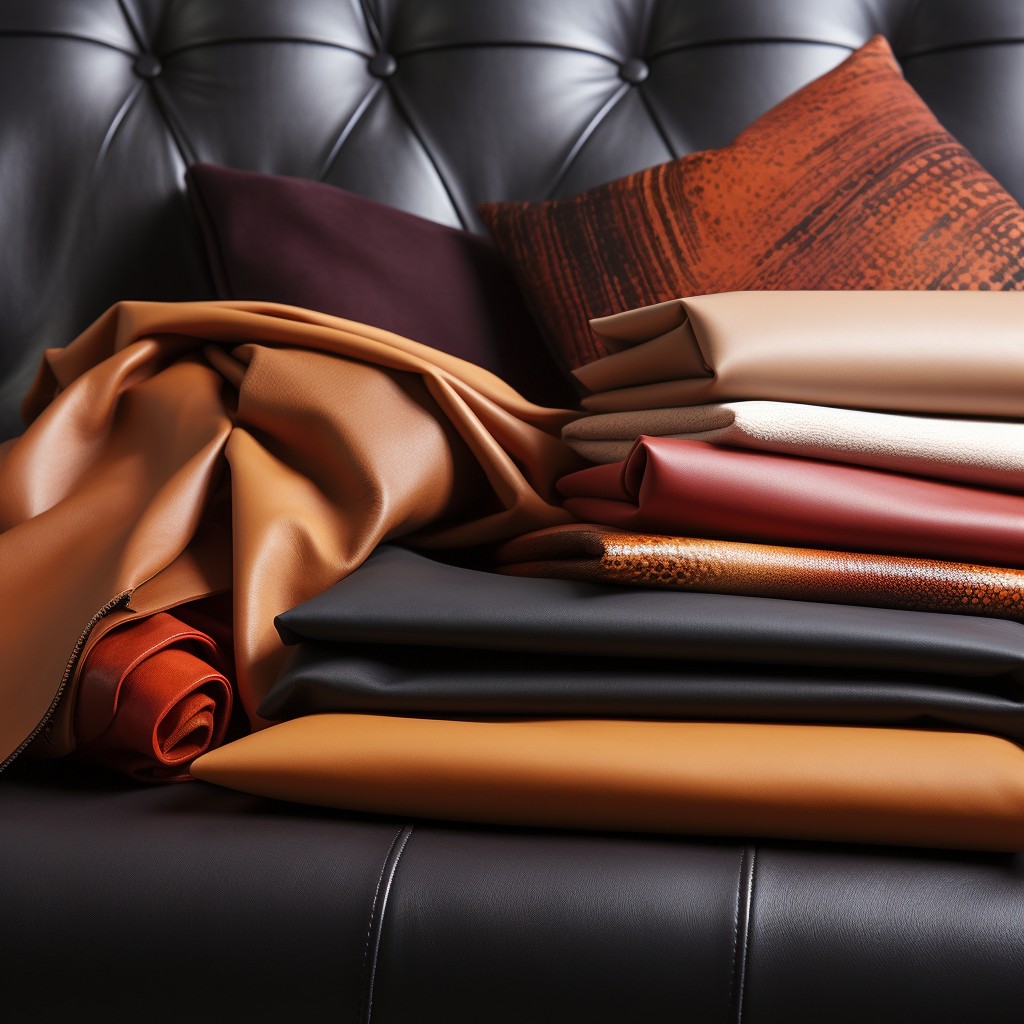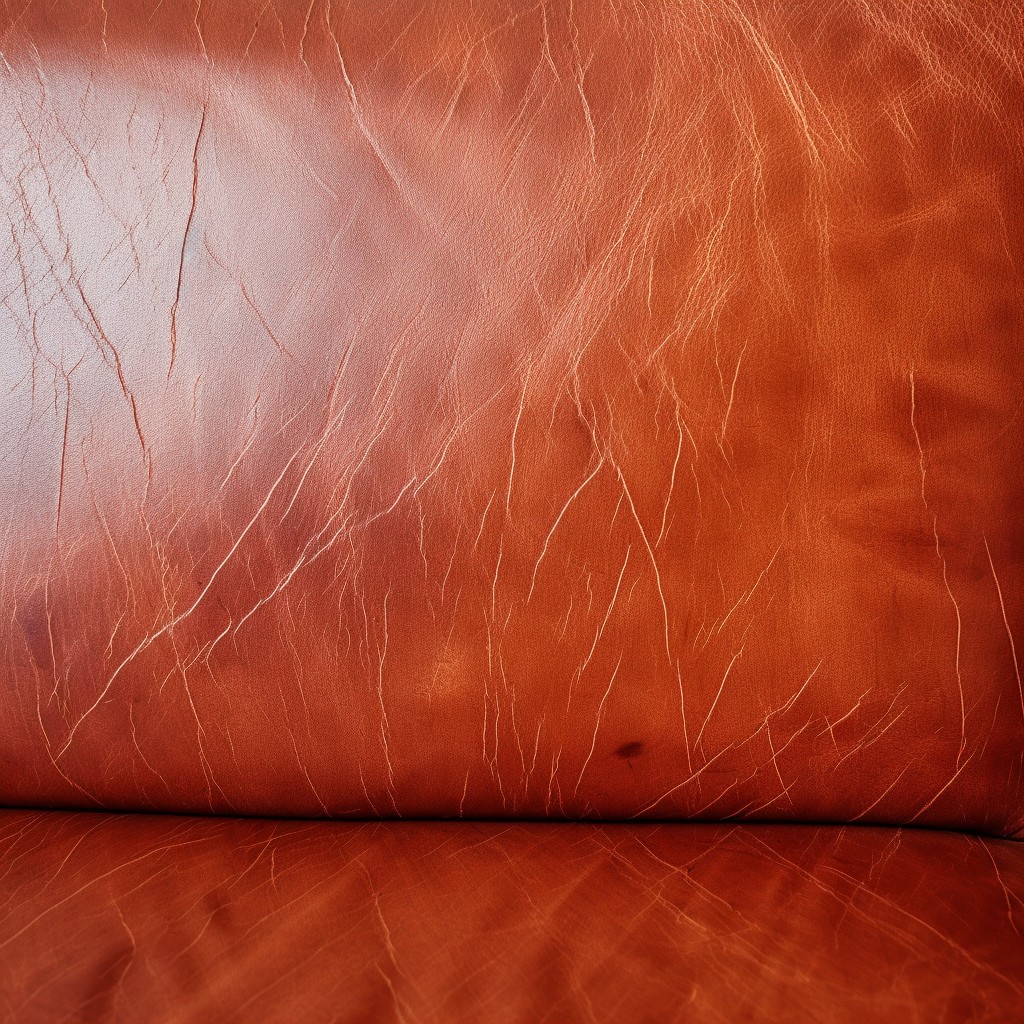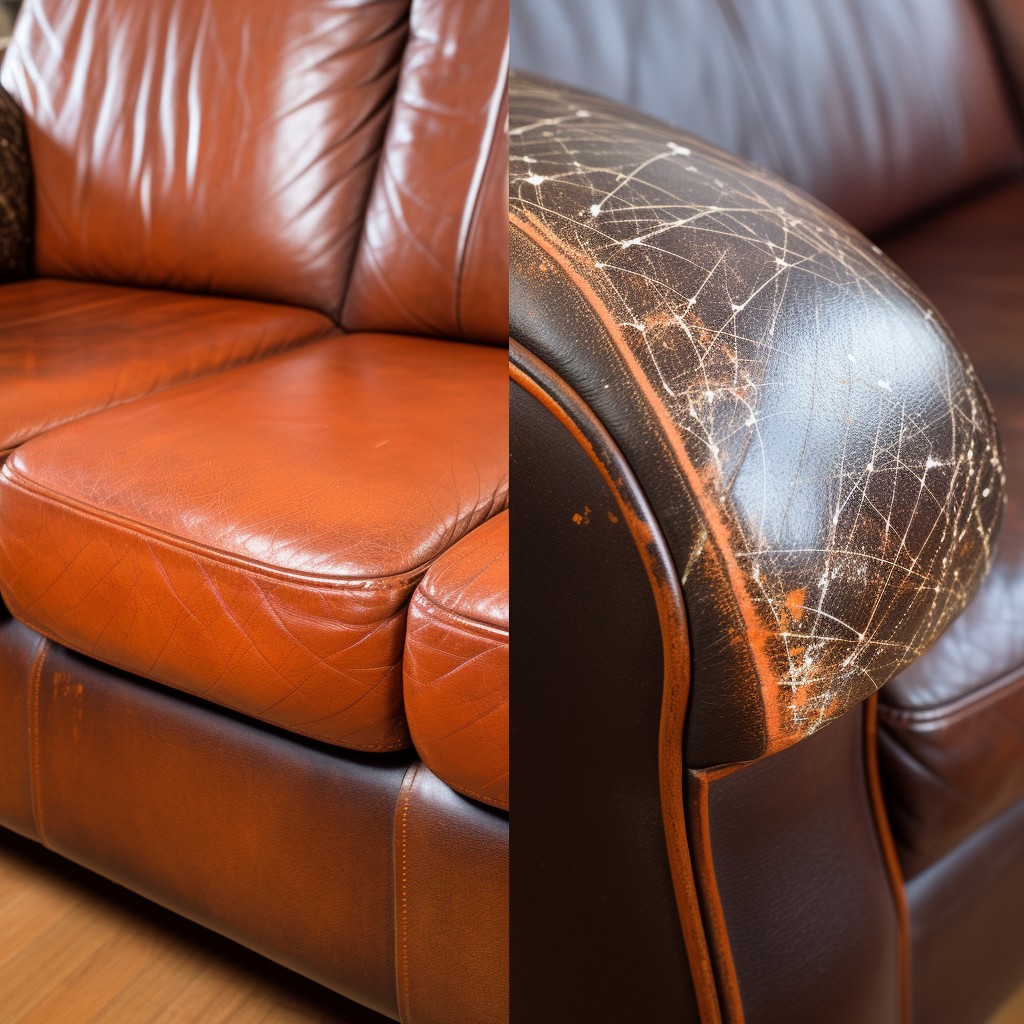Last updated on
Discover the effective techniques to eliminate unsightly scratches from your leather couch, restoring its pristine appearance and prolonging its lifespan.
Leather couches are a timeless addition to any home decor, adding a touch of luxury and sophistication to your living space. However, even the most careful and cautious owners can’t prevent scratches from appearing on their beloved leather couches over time.
Whether it’s from playful pets or accidental mishaps, these scratches can be frustrating and unsightly. But don’t worry! In this article, we’ll explore some effective ways to get scratches out of your leather couch so that you can restore its beauty and keep it looking as good as new for years to come.
So let’s dive in!
Table of Contents
Types of Leather

Knowing what type of leather you have can help you determine which scratch removal technique is best suited for your couch.
Full-grain Leather: This is the highest quality and most durable type of leather. It’s made from the top layer of cowhide and retains its natural texture, making it resistant to wear and tear.
Top-grain Leather: This type of leather is also made from cowhide but has been sanded down to remove any imperfections or blemishes on its surface. It’s not as durable as full-grain but still offers excellent quality.
Split Leather: Split-leather comes from a lower layer beneath top grain that has been split off during processing. While this material may be cheaper than other leathers, it’s less durable than full- or top-grain options because it lacks their natural fibers.
Bonded Leather: Bonded-leather isn’t technically real animal hide; instead, manufacturers create this material by bonding together scraps leftover after cutting genuine hides into shape with polyurethane or latex onto a fabric backing. Faux-Leather (PU): Faux-leather looks like real animal hide but doesn’t come directly from an animal source; instead synthetic materials are used in manufacturing process such as Polyurethane (PU) coating over fabric base which makes them more affordable option compared to genuine leathers.
Assessing the Damage

Not all scratches are created equal, and some may require more extensive repairs than others. Start by examining the scratch closely and determining its depth.
Superficial surface-level scratches can often be buffed out with a little elbow grease and some basic cleaning supplies. However, deeper cuts or gouges in the leather will require more advanced repair techniques.
Next, consider the location of the scratch on your couch. Scratches that are visible on prominent areas like armrests or seat cushions may need extra attention as they’re likely to catch people’s eyes quickly.
Take note of any discoloration around or within the scratched area as this could indicate further damage beyond what meets your eye initially.
Gather Necessary Tools

This will ensure that you have everything at hand and won’t need to stop midway through the process. The good news is that most of these items are readily available in your home or local hardware store.
Here are some of the tools and materials you’ll need:
- Soft cloths
- Leather cleaner
- Leather conditioner
- Sandpaper (fine-grit)
- Leather filler compound
- Foam brush or applicator pad
Cleaning the Area

This step is crucial because any dirt or debris on your leather couch can cause further damage during the repair process. Start by wiping down your leather couch with a soft cloth or microfiber towel to remove any surface dust and dirt.
Next, use a mild soap solution (such as dish soap mixed with water) to gently clean around the scratched area. Be sure not to saturate your leather couch with too much water as this can cause more harm than good.
Remove Dirt
Dirt and grime can accumulate in scratches over time, making them more noticeable and difficult to repair. To clean the area effectively, use a soft-bristled brush or microfiber cloth to gently wipe away any loose dirt or dust particles.
For stubborn stains that won’t come off with just a dry cloth, mix a small amount of mild soap with warm water and dip your cloth into the solution. Wring out excess water so that your cloth is damp but not soaking wet before wiping down the scratched area.
It’s important not to oversaturate your leather couch as this could cause further damage.
Scratch Removal Techniques
There are several techniques that you can use depending on the severity of the scratch.
For minor scratches, buffing it out with a soft cloth or microfiber towel may be enough to remove them. Simply apply some leather conditioner onto the affected area and gently rub in circular motions until the scratch disappears.
If buffing doesn’t work, try recoloring using a leather dye that matches your couch’s color. Apply a small amount of dye onto an inconspicuous area first before applying it directly onto the scratched surface.
For deeper scratches or gouges, consider using a leather filler kit specifically designed for repairing such damages. Follow instructions carefully when applying this product as over-application can cause discoloration or unevenness in texture.
It is important to note that these techniques should only be used on genuine leather furniture and not faux-leather materials as they require different repair methods altogether.
Buff It Out
This technique involves using a soft cloth and gently rubbing the scratched area in circular motions. The goal is to buff away any surface-level scratches, leaving your leather couch looking smooth and polished.
To begin, gather a clean microfiber cloth or sponge and apply some leather cleaner onto it. Then, use gentle pressure to rub the scratched area in circular motions until you see an improvement in its appearance.
It’s important not to be too aggressive when buffing out scratches as this can cause further damage or discoloration on your couch’s surface. Take your time with this process and repeat it several times if necessary until you achieve satisfactory results.
Recolor the Scratch
This process involves using a leather dye or pigment that matches the original color of your couch. Before applying any dye, clean and dry the area thoroughly.
To recolor a scratch on your leather couch, start by testing a small amount of dye in an inconspicuous area to ensure that it matches perfectly with your furniture’s original shade. Once you have confirmed this, apply a thin layer of dye over the scratched area using either an applicator brush or sponge.
Be sure not to apply too much pressure while doing so as this can cause uneven coloring and further damage to surrounding areas. Allow each coat time for drying before adding another one until you achieve full coverage.
Afterward, use sandpaper gently over any rough spots left behind by scratches before wiping down with damp cloth again followed by conditioning treatment for best results.
Apply Leather Filler
Leather fillers are a great way to repair deep scratches or cracks in your leather couch. They work by filling in the damaged area with a compound that dries hard and can be sanded down for a smooth finish.
To apply leather filler, start by selecting an appropriate product based on your couch’s color and type of leather. Follow the instructions carefully as each product may have different application methods.
Using a small spatula or putty knife, spread the filler over the scratch until it is level with surrounding areas of undamaged leather. Allow it to dry completely before sanding gently with fine-grit sandpaper until smooth.
Afterward, use some rubbing alcohol on cotton wool to clean up any excess residue from around where you applied this solution.
Using a Leather Conditioner
Leather conditioners help to keep the material supple, prevent cracking, and protect it from future scratches. Before applying any conditioner, make sure that you have thoroughly cleaned the area with a damp cloth or sponge to remove any dirt or debris.
Once you’ve cleaned your couch, apply a small amount of leather conditioner onto a soft cloth and rub it gently into the affected area using circular motions. Be careful not to over-apply as this can cause discoloration or damage to your furniture.
It’s important to note that different types of leathers require different types of conditioners. For example, full-grain leather requires oil-based conditioners while bonded leathers need water-based ones.
Leather Repair Kits
These kits typically include all the necessary tools and materials, such as filler compounds, adhesives, colorants, and applicators. They come in different sizes and prices depending on the extent of damage you need to repair.
When using a leather repair kit, it’s essential to follow the instructions carefully. Start by cleaning the area around the scratch with a mild soap solution or rubbing alcohol before applying any filler or adhesive.
Then apply an appropriate amount of filler compound over the scratch using an applicator tool provided in your kit.
After filling up scratches with compound material let it dry completely before sanding down excess material gently until smooth surface achieved then use colorant that matches your couch’s original shade for recoloring scratched areas.
DIY Scratch Repair
With the right tools and techniques, you can restore your couch’s appearance without having to spend money on professional restoration services.
One popular DIY method for removing scratches from leather involves using olive oil or coconut oil. Simply apply a small amount of oil onto the scratched area, then gently rub it in with a soft cloth.
This technique works best for minor surface-level scratches.
Another effective DIY solution is using vinegar and olive oil mixture. Mix equal parts white vinegar and olive oil in a bowl, then dip a clean cloth into the mixture before rubbing it onto the scratched area gently.
If you’re dealing with deeper or more severe scratches on your leather couch, consider purchasing an all-in-one leather repair kit that includes everything you need to fix any damage effectively.
Remember always test any product first on an inconspicuous part of your furniture before applying it directly over damaged areas.
Applying Leather Dye
Leather dyes come in various colors and can help restore the color of your couch while also hiding any unsightly scratches. Before applying a dye, make sure that you clean and dry the area thoroughly.
To apply a leather dye, use an applicator brush or sponge to spread it evenly over the scratched area. Be careful not to use too much as this can cause discoloration or unevenness in color.
Allow it to dry completely before using your couch again.
It’s important to note that applying a leather dye is best left for professionals as they have experience with matching colors and ensuring even application without damaging other parts of your furniture.
If you’re dealing with minor scratches on your beloved leather couches, there are several techniques available for repairing them at home without professional assistance.
Professional Restoration Services
These services can provide a more comprehensive and long-lasting solution for restoring your leather couch’s appearance and durability. Professional restorers have the expertise, tools, and materials necessary to repair even the most severe damages on your leather furniture.
When choosing a professional restoration service provider, make sure they specialize in repairing leather furniture specifically. Look for reviews from previous customers online or ask friends and family members if they have any recommendations.
While this option may be more expensive than DIY methods or using repair kits at home, it is often worth the investment in terms of quality results that will last longer without further damaging your precious piece of furniture.
Preventing Future Scratches
One of the easiest ways to prevent scratches is by placing a protective cover over your couch when not in use, especially if you have pets or children at home. You can also avoid wearing sharp objects like jewelry or clothing with metal zippers while sitting on the couch.
Another way to prevent scratches is by regularly cleaning and conditioning your leather furniture. This helps maintain its suppleness and prevents it from drying out, which makes it more prone to cracking and scratching.
Lastly, be mindful of where you place your leather furniture in the room. Avoid placing it near windows that receive direct sunlight as this can cause fading and discoloration over time.
Proper Leather Maintenance
Here are some tips to help you maintain your leather couch:
1. Keep it clean: Regularly dust and vacuum the surface of your leather couch to remove any dirt or debris that can cause scratches.
2. Avoid direct sunlight: Leather can fade, crack, or dry out when exposed to direct sunlight for extended periods.
Place the furniture away from windows or use curtains/blinds.
3. Use a conditioner: Apply a high-quality leather conditioner every six months (or as recommended by the manufacturer) to keep it supple and moisturized.
4. Be cautious with liquids: Spills should be wiped up immediately using a soft cloth; avoid using water as much as possible because it may damage the material’s natural oils.
5. Protect against pets’ claws – If you have pets at home, consider covering their nails with nail caps so they don’t scratch up your beautiful sofa!
Leather Protection Products
These products come in various forms, including sprays, creams, and waxes that create a protective barrier on the surface of your leather furniture. They help prevent scratches from forming by repelling dirt and moisture while also conditioning the material to maintain its suppleness.
When choosing a leather protection product, it’s essential to consider the type of leather you have as some formulas may not be suitable for certain types. Always read the label carefully before applying any product onto your couch.
It’s worth noting that even with these protective measures in place; accidents can still happen. Therefore it is crucial always to handle your furniture with care and avoid placing sharp objects or pets near them.
Caring for Faux Leather
Caring for faux leather requires different techniques than those used for real leather. To keep your faux-leather couch looking its best, start by wiping it down with a damp cloth regularly to remove any dirt or debris that may accumulate on the surface.
Avoid using harsh chemicals or abrasive cleaners as they can damage the material’s finish.
If you spill something on your faux-leather couch, clean it up immediately with mild soap and water before it has time to set in and stain permanently. You can also use specialized cleaning products designed specifically for synthetic materials if needed.
To prevent scratches from occurring in the first place, avoid placing sharp objects near your furniture or allowing pets with long claws onto your couch without protection like covers or blankets.
FAQ
Can scratches be removed from leather?
Yes, scratches can be removed from leather using a leather conditioner and fine sandpaper, depending on the depth of the scratch.
What takes dog scratches out of leather couch?
To remove dog scratches from a leather couch, use lanolin oil by dipping a cloth in it and rubbing it over the scratch perpendicular to the direction of the cut.
What removes scratches from leather seats?
To remove scratches from leather seats, you can create a homemade solution using a mixture of one part white vinegar with two parts linseed oil or a mixture of warm water, mild liquid soap, and a few drops of white vinegar.
What are the best products to treat scratches on a leather sofa?
The best products to treat scratches on a leather sofa include leather conditioners, leather repair kits, and leather touch-up markers.
How can you prevent future scratches on leather furniture?
To prevent future scratches on leather furniture, use a quality leather conditioner, avoid placing sharp objects near the furniture, and trim your pet’s claws regularly.
Are there any home remedies to effectively minimize the appearance of scratches on leather surfaces?
Yes, to minimize the appearance of scratches on leather surfaces, you can gently rub olive or baby oil using a soft cloth or cotton swab.





